We continue our exploration into medicinal mushrooms with a versatile variety and one you may not have heard of either: the maitake! This one sits on the fence when it comes to taste; some people love it and some people do not. What everyone can agree on are its benefits 🍄 Today, we go into the history and uses of maitake and what makes it a potent cancer-fighting fungus. Let’s get started!
*Note: Please keep in mind that I am not a doctor and you should not take the following information as a replacement for advice from a licenced professional. Always consult with a member of your healthcare team before starting any new supplements or natural compounds.
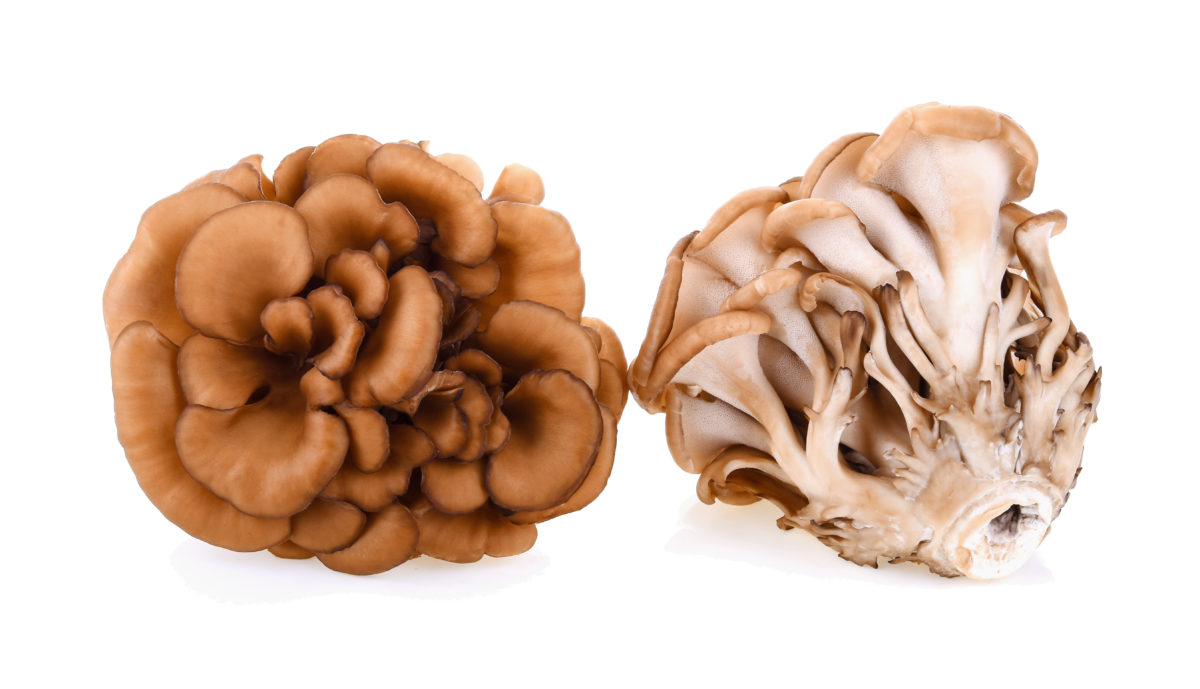
The Mesmerizing Maitake
The maitake mushroom has just about my favourite nickname that I have heard for a food. It is also called the dancing mushroom, because it was said that it was so rare a person would dance for joy when they found some. How cute is that? And also gives us a clue as to how valuable a mushroom it was considered to be in ancient times. You may have also heard it called Hen-of-the-Woods or Sheep’s Head here in North America, where it grows in the wild [1].
Besides North America, you can also find maitake mushrooms in Japan, China, and many countries in Europe [2]. In the wild, they typically grow at the base of oak trees, from the center of the trunk, or from large rotting roots rather than logs like the shitake or turkey tail [1]. This made their cultivation tricky since the popular method of inoculating logs with spores doesn’t work for this particular variety. It wasn’t until the 1990’s when a method of growing mushrooms from bags of enriched sawdust was developed did maitakes join the world of cultivation and their use in both culinary and medical endeavours become more popular [1]. The best time to search for maitake in the wild is the fall, as they do not come out in the heat of summer or the cold of winter, and even spring is spotty.
The maitake is quite a beautiful mushroom. They range in colour from grey to brown, with a creamy white underside. They grow in bunches of overlapping fans of spoon-shaped caps that are quite fleshy to the touch. And on the underside, they have pores versus gills. These caps grow from a central, underground tuber the size of a fist [2]. The maitake is sometimes called the king of mushrooms because of the incredible size they can grow to. It is not at all abnormal for a single maitake clump to weigh 45 pounds, and they can get as big as 88 pounds [2]! No wonder people would dance for joy upon coming across a haul that size.
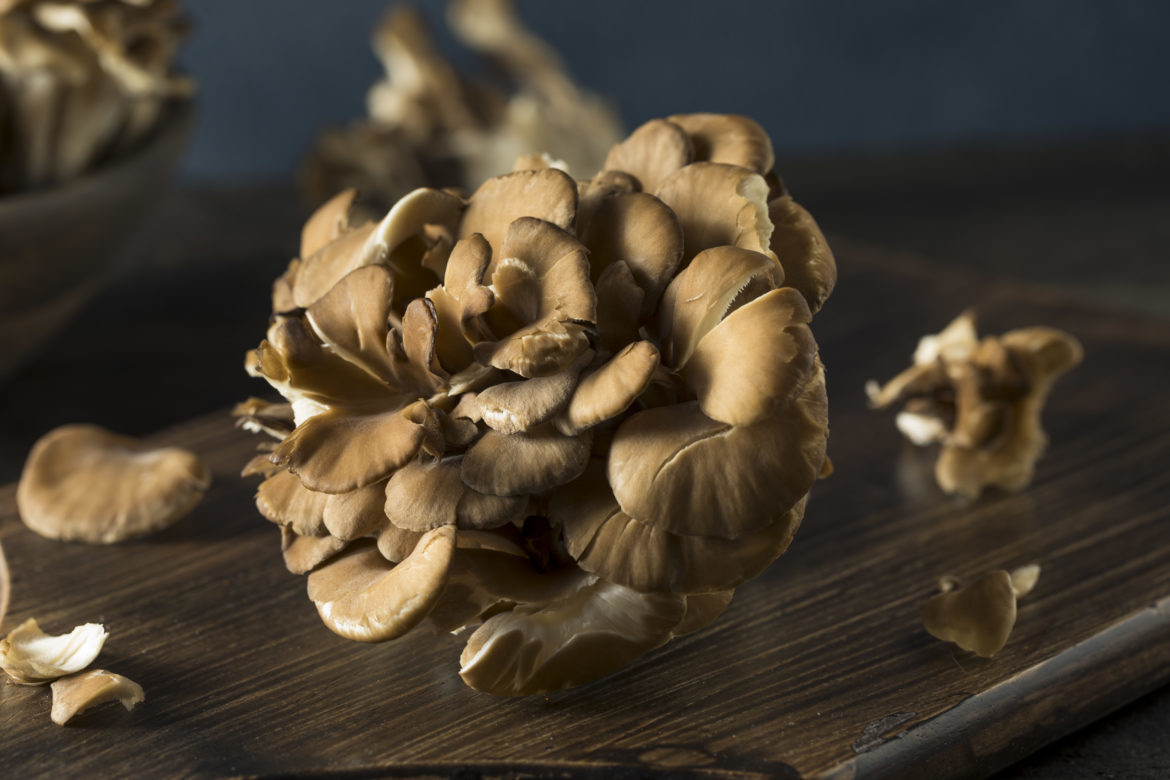
What’s their deal?
Unlike some of the other mushrooms we have covered, maitake is coveted for both its culinary use and medical benefits, especially so once their cultivation was figured out and they became much more readily available.
Maitake mushrooms are often used in Japanese cuisine and lend a delicious, woody flavour to dishes that people often liken to morels. The flavour can be quite intense, so it is best to start low and make sure you enjoy the taste before adding too much. The texture isn’t like that of many mushrooms, forgoing the rubbery feel for something much more feathery and delicate [3].
When it comes to their medicinal use, maitake mushrooms have been a part of Chinese medicine since as early as 206 AD [4]. Historically, they have been used for such conditions as type 2 diabetes, metabolic syndrome prevention, supporting weight regulation, improving the immune system, osteoporosis, high blood pressure, and of course cancer [4].
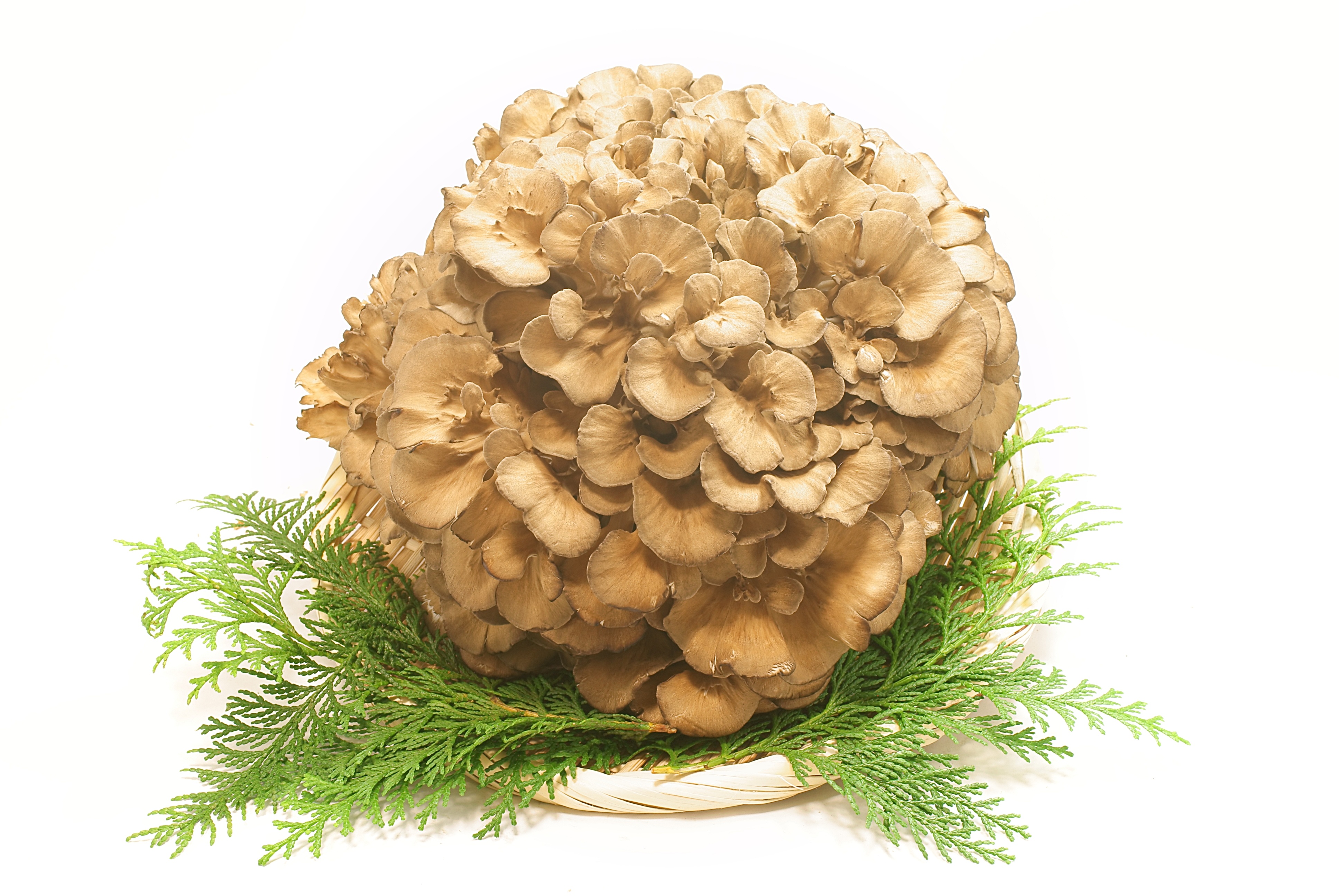
Cancer Crusader
The bioactive compound of maitake that has medicinal benefits is called D-fraction, the active component of it being beta glucan, like most mushrooms [5]. And man oh man, does D-fraction do a lot for us.
Immune Support
The immunomodulating effects of mushrooms are one of the areas most heavily studied when it comes to mushrooms for medical use, and these effects are particularly important when it comes to cancer and the anticancer activity of maitake. One 2013 study discovered the method by which D-fraction stimulates an immune response. After oral administration, D-fraction was not transferred to the blood but was instead captured by immune cells such as macrophages and dendritic cells, which are responsible for trapping antigens. The captured D-fraction was then transported to the spleen, where a systemic immune response was thereby initiated [6]. This immune response was associated with an increased response in tumor-antigen specific T cells (immune cells that detect and destroy tumour cells), an increased infiltration of the activated T cells into the tumor, and a decreased number of cells that are caused by tumours and suppress the immune system [6]. Another study found that maitake stimulated the cellular but also the hormonal branches of the immune system [7]. Through these mechanisms, maitake supports the immune system, making it more effective and decreasing those cells which damage it. Due to these actions on multiple levels, as well as the many other benefits I will explore below, maitake is a very versatile tool in the fight against cancer.
Tumouricidal and Tumour Suppressive Effects
Beta glucan (and therefore D-fraction), has been shown to have many beneficial effects when it comes to cancer, not the least of which is its tumouricidal and tumour suppressive effects. For tumour suppression, in a variety of studies using mice with different cancers, D-fraction was shown to reduce melanoma growth by 27%, breast cancer by 64%, skin cancer by 75%, and sarcoma by a whopping 88% [8]! Another study found that exposure of breast cancer cells to D-fraction resulted in the modification of the expression of 4068 genes (either turning those with anticancer effects on or turning those that promote cancerous activity off), including those that are involved in the inhibition of cell growth and proliferation as well as cell cycle arrest (stopping the rapid replication of cancer cells and therefore the growth of tumours) [9]. Many of the tumouricidal effects are because of the immunomodulating effects described above. When the immune system is functioning optimally, it will be much more effective at killing tumour cells.
D-fraction has even been proven to prevent cancer growth in healthy cells, making it an excellent choice for those wishing to prevent a recurrence or ever getting cancer in the first place. One study gave known carcinogens to two groups of mice, one that was receiving only feed laced with carcinogens and another that was receiving the same feed but also an oral supplement of D-fraction. At the end of the study, only 10% of the group who was taking D-fraction had detectable liver tumours, while 100% of the control group that did not receive D-fraction were found to have tumours [8].
Cytotoxic Effects
D-fraction from Maitake mushrooms has been found to decrease the viability of cancer cells (their ability to maintain or recover their health) and increase apoptosis (programmed cell death). One study from 2011 incubated D-fraction with breast cancer cells. After 24 hours, cells were shown to have reduced viability and apoptosis was statistically significantly increased [10]. They discovered that D-fraction achieves this by upregulating the genes (basically, flipping the switch to turn them on) that transcribe for BAK-1 and cytochrome c, two proteins that are directly involved in apoptosis [10]. Cancer cells are so dangerous because they do not follow the directive to die. Instead, they continue to replicate endlessly and eventually those out-of-control cells form a cancerous mass. Inducing apoptosis and decreasing cell viability are vital steps to stopping cancer.
Antiproliferative and Antimigration Effects
The same study that found that exposure of breast cancer cells to D-fraction resulted in the modification of the expression of 4068 genes including those involved in inhibition of cell growth, proliferation and cell cycle arrest, also discovered that D-fraction affects 2 genes that play a role in blocking the migration and metastasis of tumour cells [9]. One gene (ITGA2) has been found to be significantly reduced in breast cancer compared to normal breast tissue, and the loss of the expression of this gene is highly correlated with malignant disease and with disease progression [9]. The second gene (ITGA9) has been shown to be downregulated or lost in 44% of breast cancer tumours, and this downregulation has been associated significantly with the progression of lung cancer [9]. Increasing the expression of these two genes could be why maitake has such an effect on the proliferation and metastasis of cancer.
Increasing Drug Sensitivity
Cancer cells are tricksy, and they adapt to evade treatments and become resistant to them. This is quite an issue for those who undergo treatment for long periods of time, such as those with metastatic cancers. Vitamin C has been studied for its ability to increase the sensitivity of cancer cells to conventional treatments and natural anticancer compounds, and it appears that combining maitake with vitamin C has an even more effective result. “Synergistic potentiation of PDF [D-fraction] with vitamin C demonstrated in vitro is rather interesting and may have clinical implication, because such combination therapy appears to help improve the efficacy of currently ongoing cancer therapies” [8]. This could be very significant for those whose cancers haven’t responded well to chemo and for those receiving long-term treatment, for whom the risk of cancer cells becoming resistant to chemo is much higher.
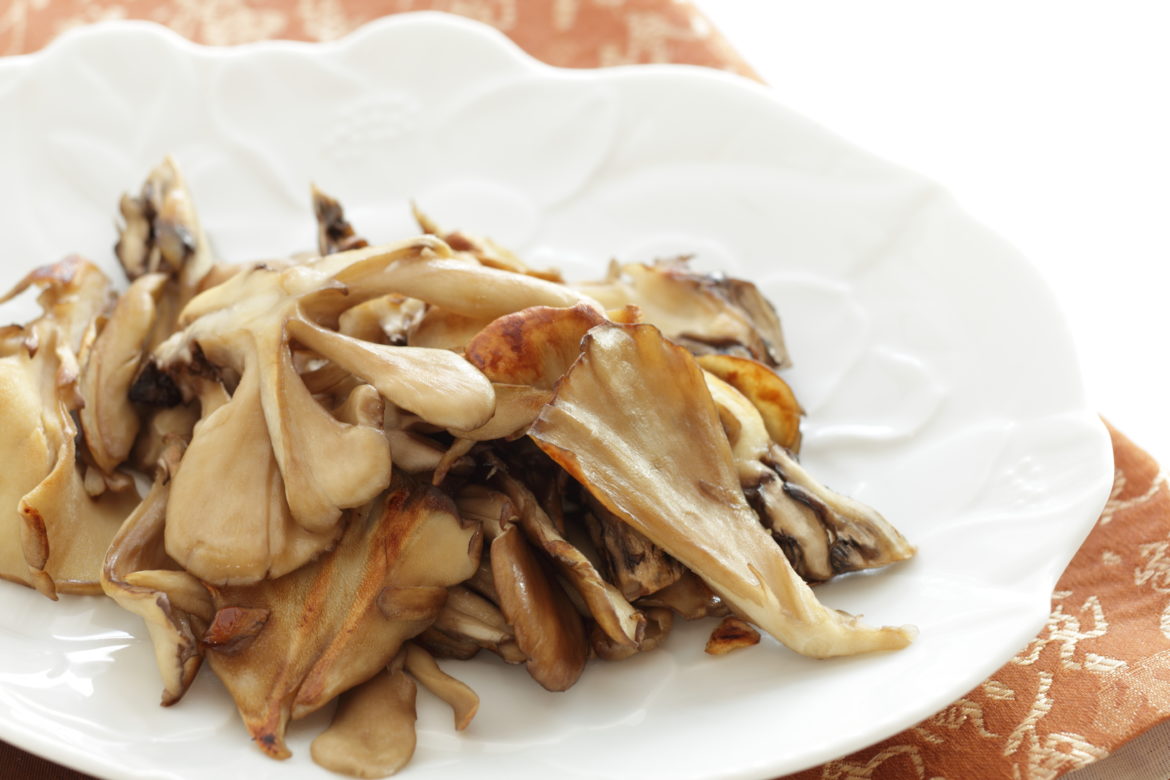
These fungi sound fantastic! But what do I even do with them?
*These recommendations are similar to those in the previous parts of this series. The new additions are at the top, so feel free to read just the new one(s) or the full list if you want a review or haven’t read the other posts in this series.
There are a few different ways to use maitake mushrooms. Many people love the flavour, so there are culinary options for this one like with shitake mushrooms. As with the incorporation of any mushroom, some methods of use are easier to incorporate than others while some methods result in easier absorption. As always though, when it comes down to it, you want to pick the method which will be the easiest for you to maintain; from my experience, no matter how good something is for you, if it is a hassle to do and not relatively easy to fit into your routine, eventually you will drop it.
In Cooking
Because these mushrooms do have a pleasant taste to many, the easiest way to incorporate them into your protocol might be by cooking with them. As I mentioned above, some do find the flavour quite intense, so it is best to try just a little bit first before going wild. Try them in soups, stews, omelettes, stir fries, and more! If it calls for mushrooms and you enjoy the taste, you can use maitake.
Capsules
If you don’t like the taste of maitake mushrooms, capsules are the easiest and most pleasant method for adding them to your protocol. For maitake, the usual dose can range from 2-4 capsules a day that are usually somewhere between 500mg and 1000mg per capsule. This method is super easy to work into your routine, as many of us are already taking supplements and it doesn’t take much to add one more. The issue with capsules is that they can be difficult for your body to absorb, so if you know that you have trouble making proper use of supplements, you may be better off choosing one of the following options.
Powder in smoothies or broth
If you already have smoothies in your diet, a great way to get your maitake in is to buy it in powder form and add a teaspoon to your smoothie. I used to take my mushroom powders this way and, although it wasn’t super delicious, I didn’t mind the taste too much and took them this way for months.
Although this is a convenient option for those making smoothies anyway and a fine choice if it is the easiest for you to maintain, smoothies do tend to be cold and, like the other varieties of medicinal mushrooms I have discussed, maitake mushrooms are better absorbed when they are warm. “[…] medicinal mushrooms have low bioavailability unless they undergo a hot water extraction process. Meaning, we are not able to absorb mushrooms’ nutrients because the fungi lock their immune activating beta-glucans and polysaccharides in chitin cell walls, which are indigestible to humans” [11]. So, make sure your capsules and powders were hot-water extracted by the manufacturer, and then it is best to take them using something warm. A way to do this is to whisk a teaspoon of maitake powder into some bone broth or soup. The mushroomy flavour goes well with the savory broth, making the taste more palatable, and the heat makes it easier for your body to absorb.
There is much controversy over soy as a phytoestrogen for those who have/had hormone driven cancers, but most experts agree that the less processed and fermented forms are fine to include in your diet in moderation and can actually help to prevent the recurrence of hormone positive cancers, although the results of research have been varied. Miso soup then is a tasty base to which to add your maitake powder, and I find that it covers the taste better than other broths. Plus, you are also getting a fermented food into your diet, which your gut buddies will love!
I love this mushroom broth recipe from Handmade Apothecary. You can use it as a base for soups, stews, gravy, curries and more! I love this one because it makes it easier to work mushrooms into your regular diet. Anytime a recipe calls for stock, you can use this broth. This recipe uses turkey tail and chaga mushrooms, but feel free to replace either with maitake or add it in and use all three! I would recommend making a small batch first and seeing how you like the taste, otherwise you may end up wasting a bunch of mushrooms if the maitake flavour is not something you end up enjoying.
Tea with powder or by boiling mushroom pieces
If soup isn’t your thing, another way to use heat to up the absorption factor is by making maitake tea. You can make a tea quite easily by boiling pieces of the dried or fresh fungi. Simply add about 1 tablespoon of mushroom pieces for dried and 2 tablespoons for fresh to 2 cups of boiling water, boil for 20-30 minutes, strain and enjoy. Leftover tea can be stored in the fridge for 3-4 days.
If you already have or can only find maitake powder, you can also whisk a teaspoon of powder into a cup of boiling water, add some lemon or a peppermint tea bag, and enjoy! As I said above, many people love the flavour of maitake, but it can be quite intense and you may find the taste too strong. If you do, try adding a little honey or waiting for it to cool and calling on your early twenties to treat it like a shot and just down it!
Ready-made products
If the homemade smoothie, soup or tea options aren’t for you, there are lots of ready-made mushroom products on the market that make including them in your diet more palatable. My favourite company by far is Four Sigmatic for the quality and variety of their products. Plus, they are such nice people!
Whether you get them from Four Sigmatic or not, some of the types of products you can expect to find include:
- Coffees
- Teas
- Chocolates
- Protein Powders
- Elixirs
Play around with all of these options and see which works best for you. I personally take my maitake as a powder often in broth because I have a big bag of it to use up. Whenever I have a bowl of soup (which is quite often) I whisk in a teaspoon of two of my mushroom powders (turkey tail, shiitake, reishi, chaga, and maitake). It is a convenient way to incorporate it because I’m having soup anyway and it often masks the flavour enough.
Remember, consistency is key. Even if it isn’t all absorbed, some mushroom every day or most days is better than not having any at all, so try them out and see which method fits most comfortably into your routine. And if you find another way to include mushrooms in your diet, a tasty recipe or a more convenient method, please feel free to share it in the Facebook group or let me know via the Contact Me page!
Happy Healing ❤️
References
- The History of Maitake Cultivation – https://www.mycopia.com/blog/2013/08/12/the-history-of-maitake-cultivation
- Maitake Mushrooms – https://permaculturenews.org/2019/10/03/maitake-mushrooms/
- How to Cook Maitake or Hen of the Woods Mushrooms – https://www.thechoppingblock.com/blog/2014/10/cooking-maitake-hen-of-the-woods-mushrooms.html
- Maitake – https://www.mycomedica.eu/maitake.html
- Maitake Mushrooom: History + Benefits – https://birchboys.com/blogs/about-our-chaga/the-history-and-health-benefits-of-maitake-mushroom
- Oral administration of soluble β-glucans extracted from Grifola frondosa induces systemic antitumor immune response and decreases immunosuppression in tumor-bearing mice. – https://www.ncbi.nlm.nih.gov/pubmed/23280601
- Immune-enhancing effects of Maitake (Grifola frondosa) and Shiitake (Lentinula edodes) extracts – https://www.ncbi.nlm.nih.gov/pmc/articles/PMC4202470/
- Synergistic potentiation of D-fraction with vitamin C as possible alternative approach for cancer therapy – https://www.ncbi.nlm.nih.gov/pmc/articles/PMC2840554/
- Genes Related to Suppression of Malignant Phenotype Induced by Maitake D-Fraction in Breast Cancer Cells – https://www.ncbi.nlm.nih.gov/pmc/articles/PMC3719462/
- Maitake (D fraction) mushroom extract induces apoptosis in breast cancer cells by BAK-1 gene activation – https://www.ncbi.nlm.nih.gov/pubmed/21480800
- Why People are Shrooming Out on Medicinal Mushroom Tea – https://www.eater.com/2015/3/11/8181107/why-people-are-shrooming-out-on-medicinal-mushroom-tea

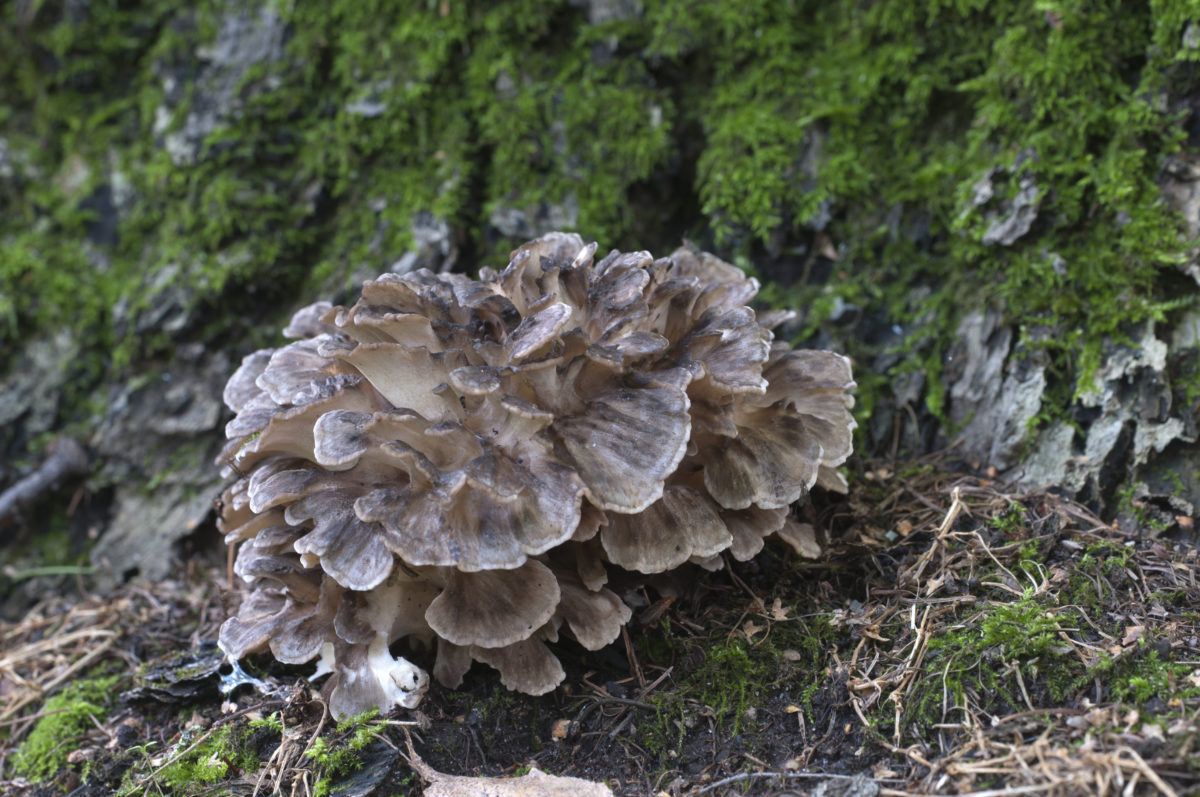


Hi there to every single one, it’s actually a nice for me to visit this site, it contains
valuable Information.
Hi there and welcome! So glad you have found the information helpful and valuable 🙂 I would also like to invite you to join our free Facebook group Solis Cancer Community where I share mental health tips, recipes, resources and more! If you haven’t already, you can do so here: https://www.facebook.com/groups/2244734982522750/. Thanks for reading!